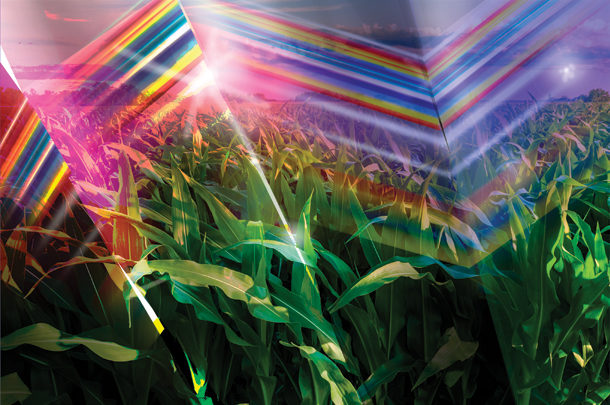In reality, NIRS technology has been around since the 19th century, and the first industrial applications were in the 1950s.
Nowadays, NIRS is utilized in many fields, including agriculture, physics, physiology and medicine. Police use NIRS to scan and immediately identify pills confiscated from alleged criminals. NIRS can help determine when sausage is cured, which tomato is the sweetest, and it can even tell what a person’s body fat is, instantly, simply by shining a light on them.
The basis of NIRS is light. Light is shone onto a sample, and some is absorbed by the sample, whereas another fraction bounces back onto a sensor. The sensor determines how much and what type of light is reflected by the sample.
The principles behind NIRS are similar to how our brain recognizes color, based on the light reflected through our eyes. When we see a green stalk of corn, it means the corn stalk absorbed all colors of light except green.
Similarly, when a sample of feed is scanned by NIRS, different nutrients (protein, moisture, starch, etc.) absorb different wavelengths of light. For example, moisture absorbs light in the near-infrared region around 1,200, 1,400 and 1,900 nm, whereas protein absorbs near-infrared light around 1,500 and 2,000 nm. Therefore, when a sample is scanned, the quantity of water could be determined by how much light at 1,200, 1,400 and 1,900 nm is reflected.
In modern agriculture, NIRS is used widely. Water tends to create the biggest peaks in a sample, and these can sometimes “drown out” other nutrient peaks. Therefore, most of the time, samples are dried before scanning in commercial laboratories, and most hand-held NIRS meters focus on predicting water only on wet samples.
There is a lot of value in immediately knowing the moisture content of a feed. Moisture is the number one determining factor of silage quality – too dry, and the silage is prone to poor digestibility and spoilage; too wet and the silage is prone to excessive runoff and clostridia. Furthermore, even a small moisture change, such as due to a rain event, can cost quite a bit, and correcting the diet for moisture changes can be beneficial.
Although NIRS is fast, easy and cheap, it does have some pitfalls users should be aware of. It may not be as accurate as wet chemistry methods when predicting certain nutrients. For example, NIRS is typically excellent at predicting protein, starch and fiber components, but when it comes to measuring the quantity of minerals in a feed, it is best to stick with wet chemistry methods.
Laboratories create equations to quantify various nutrients by comparing the light absorption spectra of a sample to the known wet chemistry analysis. It often takes thousands of samples to create accurate equations – the more samples, the more accurate the equation.
Laboratories can sell these equations to other companies that may not have access to a wet chemistry laboratory. For example, companies that sell hand-held NIRS equipment need to use equations to correlate the reflectance reading to a nutrient.
Historically, NIRS has been confined to laboratories, not only because its operation has been technical and difficult but also because the machinery has been quite expensive. More recently, machines are being sold that are not only affordable for the average person but also easy to use and small.
For example, the HarvestLab by John Deere is affordable for many producers, is easy to use and can fit on a workshop bench or can be built into a chopper. Another new example is a portable NIRS called SCiO, by Consumer Physics. SCiO is roughly the size of a garage door opener and has a very easy-to-use interface on the user’s cellphone.
NIRS meters differ in how many wavelengths they shine on a sample, the quality of the sensor and the reliability of the technology. This is what results in the vast difference in prices of NIRS readers (as low as a few hundred dollars up to tens of thousands of dollars).
The NIRS scanner from Dinamica Generale can be installed directly on different agricultural equipment such as combines, forage harvesters, forage wagons, balers, slurry tankers, feed mixers and portable devices. It can measure nutrients and couple the readings with GPS coordinates to track nutrient changes over different parts of the field. This technology allows producers to adjust fertilizer rates while maximizing yields and minimizing input costs. This company also offers hand-held devices as well.
Accuracy is the number one concern with all NIRS meters. Looking forward, the ideal NIRS reader would be small, reliable, have an easy-to-use user interface, and it would be accurate. I would love to see a hand-held NIRS reader that could measure the amino acid profile of the feed, the mineral content of hay, particle size of grain, or corn silage processing score. The uses for these would be boundless.
As with all technology, results are only as good as the user. I have faith we, as an industry, are just scratching the surface of the capabilities of NIRS technology.
ILLUSTRATION: Illustration by Corey Lewis.











